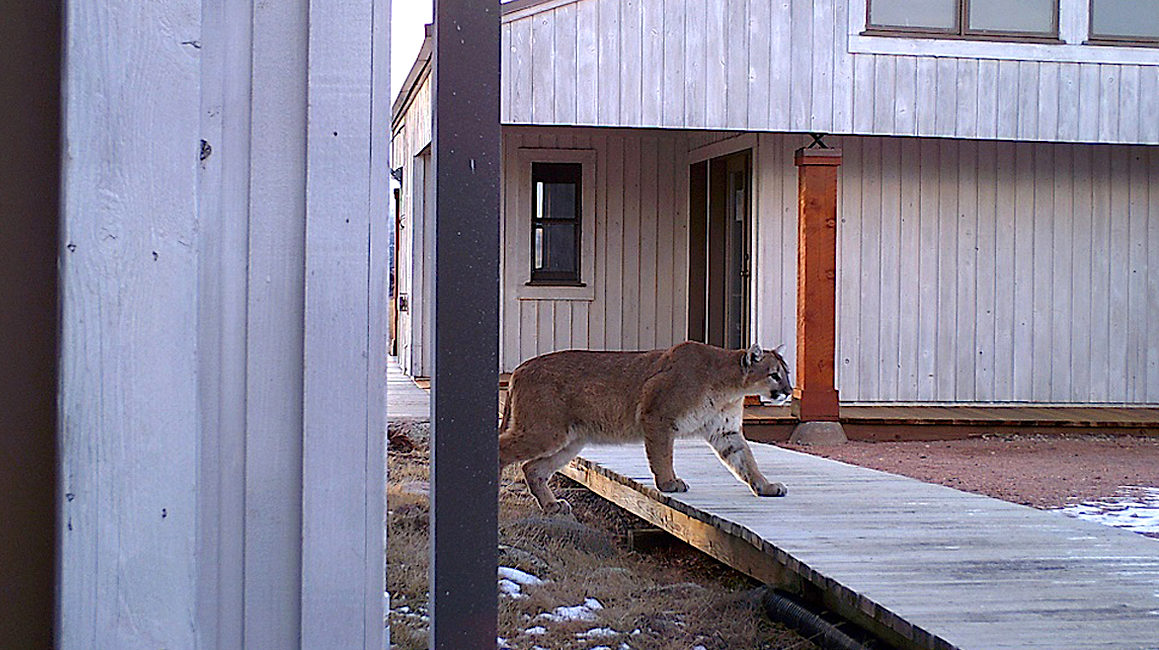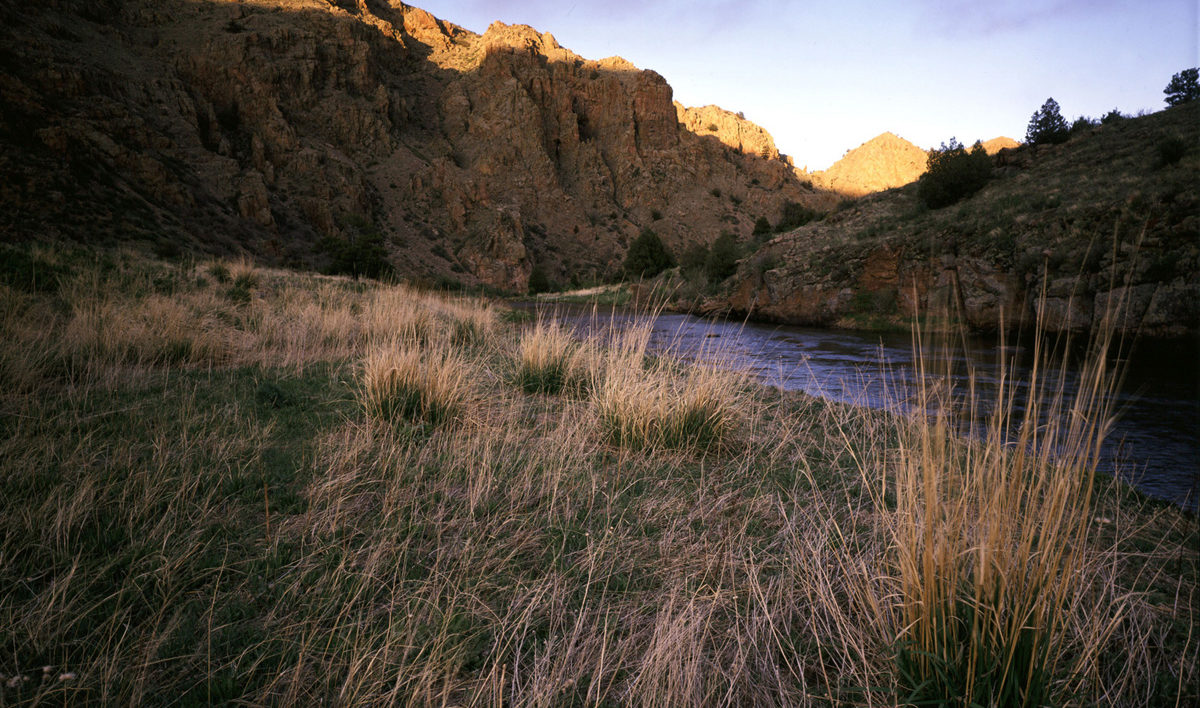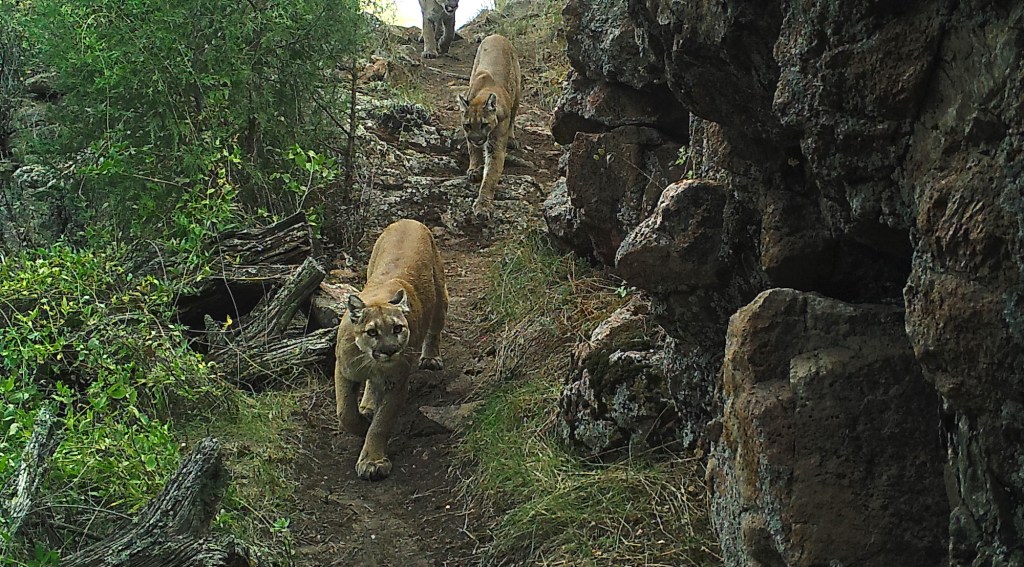For more than 30 years, The Nature Conservancy’s Phantom Canyon Preserve has sought balance between the needs of people and the needs of wildlife.
The 1,200-acre preserve is situated in one of the last roadless canyons on Colorado’s Front Range, where herds of bighorn sheep and elk roam. It is home to more than 200 plant species, including some that are rare and endemic.
But the preserve sits only 30 miles from the growing city of Fort Collins. It is connected to a landscape dotted with private ranches. On its way to fields and cities the North Fork of the Cache la Poudre River provides habitat for native fish like the colorful Iowa darter, and for the American dipper, a bird that forages underwater.
Downstream, the river is utilized for irrigation and utilities. Its water is essential for everything from hay for livestock to the region’s famous breweries.
A recent trail camera photo taken at Phantom Canyon Preserve perhaps serves as the perfect illustration of the blurry line between the human and the natural. It captures a mountain lion striding, not through wilderness, but through the preserve’s cluster of buildings.

“The preserve is not open for six months of the year,” says Sally Ross, The Nature Conservancy in Colorado’s Laramie Hills program director. “I visit a couple times a month and collect the cards from the trail camera. Usually I just sort through lots of rabbit photos. But this time, there was this big female lion, walking right in front of the bunkhouse.”
Despite the surprise of that particular mountain lion, Phantom Canyon is cat country. About 18 months ago, Ross began noting more scat and tracks on her visit to the preserve. In the mid-2000’s, the Colorado Department of Fish and Wildlife culled mule deer due to the presence of Chronic Wasting Disease. The deer herd has since increased, and with it came signs of mountain lions.
Not long after Ross began noticing scats, a trail camera captured this footage of a mountain lion with cubs.
Trail cameras at the preserve have captured images of other interesting wildlife, including black bears, bobcats, elk and mule deer.
While Ross acknowledged this is anecdotal, she has noticed one change around preserve headquarters with the increase in mountain lion sign and sightings. “When I started here three years ago, the rabbits would chew the wires on cars we parked around the preserve. It cost TNC a lot of money,” she says. “Since the increase in lion signs, we haven’t had any issue with rabbit damage.”

More About Phantom Canyon Preserve
The Nature Conservancy acquired the 1,200-acre Phantom Canyon Preserve in 1987, primarily to protect native plants. Since then, it has become an anchor to build community engagement and to protect private lands on the Colorado Front Range.
The Conservancy has worked with utilities, land management agencies, private landowners and other conservation groups to create a 22-mile corridor that connects high elevation public lands in the west (Rocky Mountain National Park) to low-elevation private ranches in the east.
Since the effort began, there have been approximately 100,000 private acres protected under some form of conservation management, which is connected to 110,000-acres of publicly protected lands.
Today, Phantom is used as a place to inspire, educate, and demonstrate to our users the impact of conservation and good land management practices. Read more about the project.




Your narration on the habitat of these creatures is giving me new hope that we can preserve the areas where these animals roam and live. So many of our free ranging animals have come under attack because their normal roaming sites have become human places for homes or camps. We need to protect these areas for the animals. Once a species is killed off, we have no one to blame but our lack of for sight and willingness to speak-up for them. Please keep up the good work and stories.
Thanks for sharing this incredible footage of the mountain lions. I live in Santa Cruz, CA – specifically in Live Oak, next to a riparian corridor. Occasionally, I we have had sightings in our area – even one in a small tree in a strip mall by the Dollar Store. And I swear I saw one at the end of the street, one night, 10 pm as I walked my dog. It was just sitting there – very tall – much taller than a coyote, which we also have. We did not walk in that direction to check it out. Ha!
Great story
Mountain lions are also known in Griffith Park, Los Angeles. While out riding I encountered one, some years ago, and while eyeing my horse the big cat also knew a human was involved so just backed away. Much to both my horse and my relief !
As my friend who spends much of the summer in the wilderness here in Montana said, “if you see one mountain lion 100 have seen you
Those video clips and photos are amazing! Keep up the good work, TNC!
With great respect,
Brad Dunker
…good to see the cats there. Thanks for the effort.
Tom Baugh
biologist/ecologist
Very cool and interesting story. We cherish our mountain lions here in Southern California, too, although they live in a precarious balance with all the urbanization here. Thanks to the Nature Conservancy for the stewardship, protections and education you offer. And the emails! I’m always up for a good big-cat story, and the photos and video footage here of the Phantom Canyon cats are terrific.
Love those lions. We lived outside of Bayfield on the south side of the San Juans and often bear and deer visited our area. On his way home from work one evening my husband saw a mountain lion crossing the dirt drive leading to our house. One afternoon my cat stood on the edge of our deck staring down at at bobcat staring up at him from below. So wonderful living in places like this! Must preserve them.
That is so beautiful!!!
I am so grateful that TNC is protecting our wildlife and plants in this preserve and is work is working with the locals to make it all work peacefully, thank you .
What a beautiful place. The geology and the ecology seem to fit together so well… so happy to see the big cats back in their niche there! As a geology instructor at Lamar University (where we don’t have many rocks – except the ones that we have for study) and an avid nature photographer – that place looks like the perfect place to hike around and visit with nature. Thank you for being a good steward and sharing these images with us. Friend of Wendy Ledbetter 🙂 Perhaps I will get to visit one day.
http://www.cynthiaparish.com
You made my work morning with this email – thanks!
These were great photos and good reminder of what the work the NC does here in Colorado. Thank you, you encouraged me to check that my membership is current! I’l have to look into signing up to tour or visit this place sometime.
wow matthew, what an honor. i have been near there when i visited my son kevin who was living in denver & boulder
Very cool story. I enjoyed reading it. I usually don’t take the time to read emails in-depth. But, many of The Nature Conservancy’s, Cool Green Science and other articles are educational and inspiring for me so, I look at them a little more carefully.
I know that a Mountain Lion is larger than a Bobcat but, are there other differences? The Mountain Lion is more of a threat than a Bobcat is, correct?
Thanks,